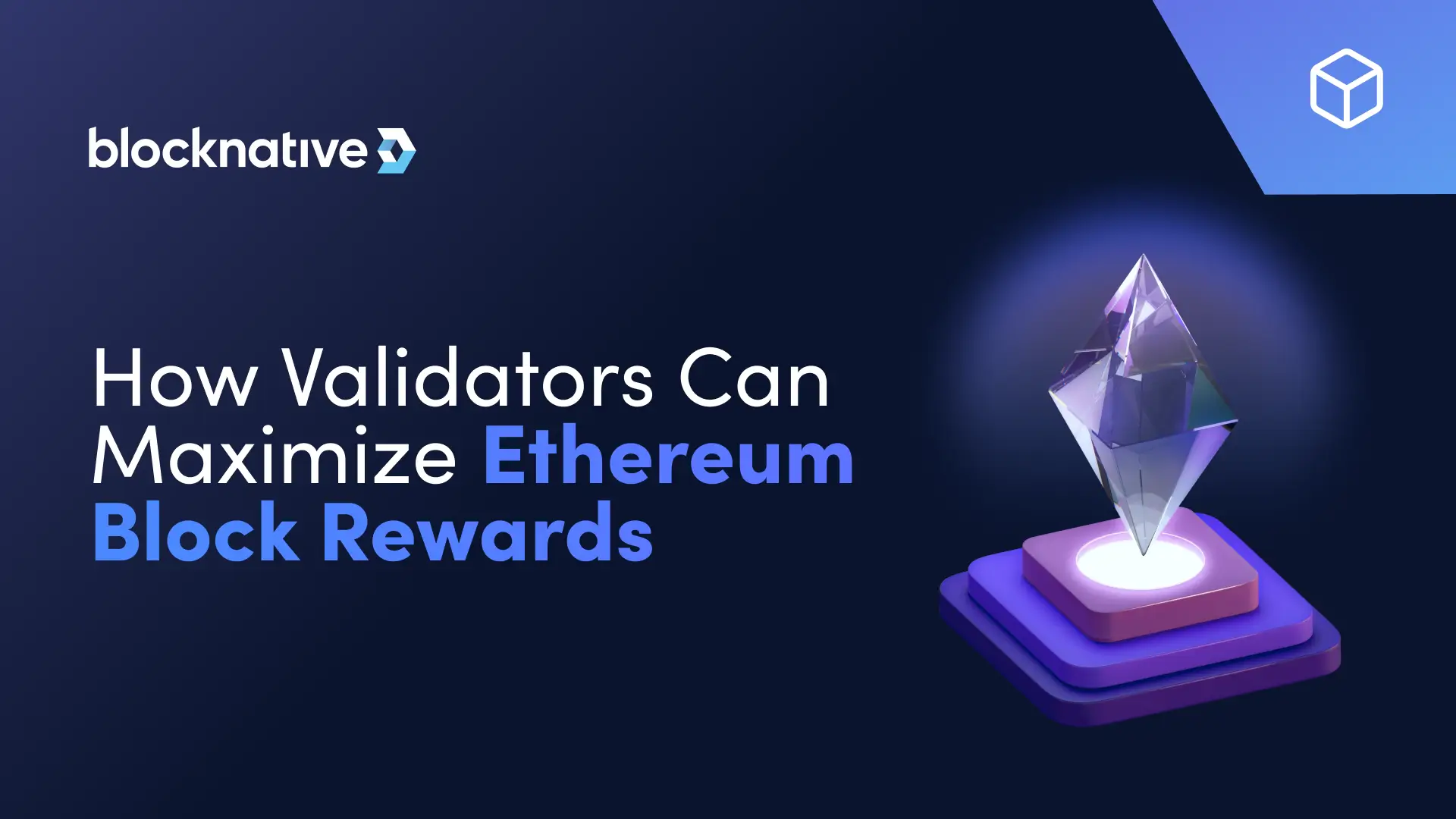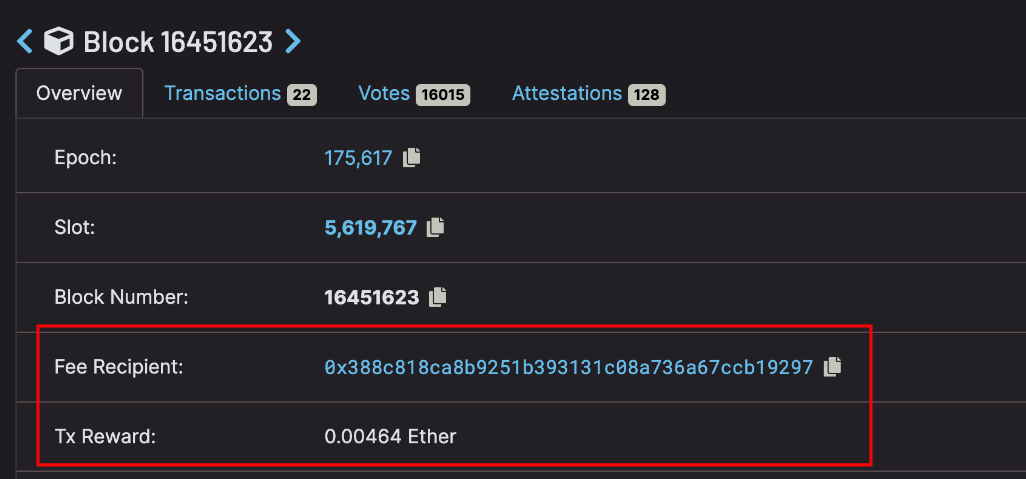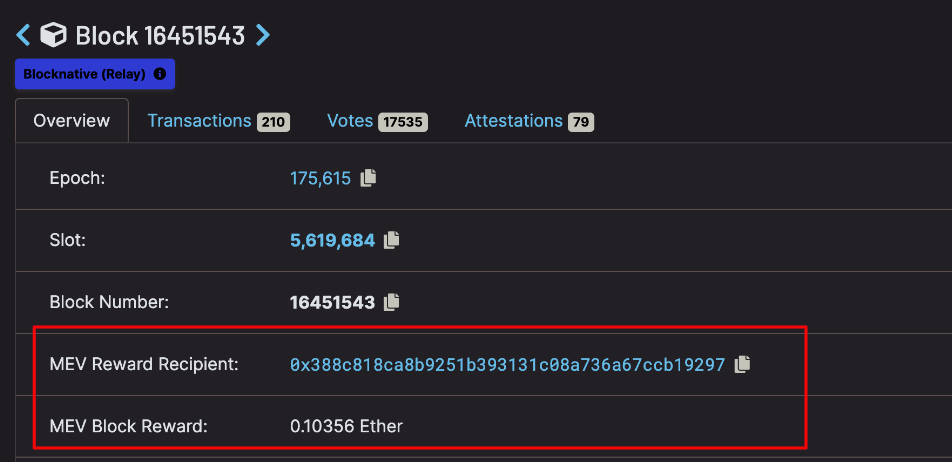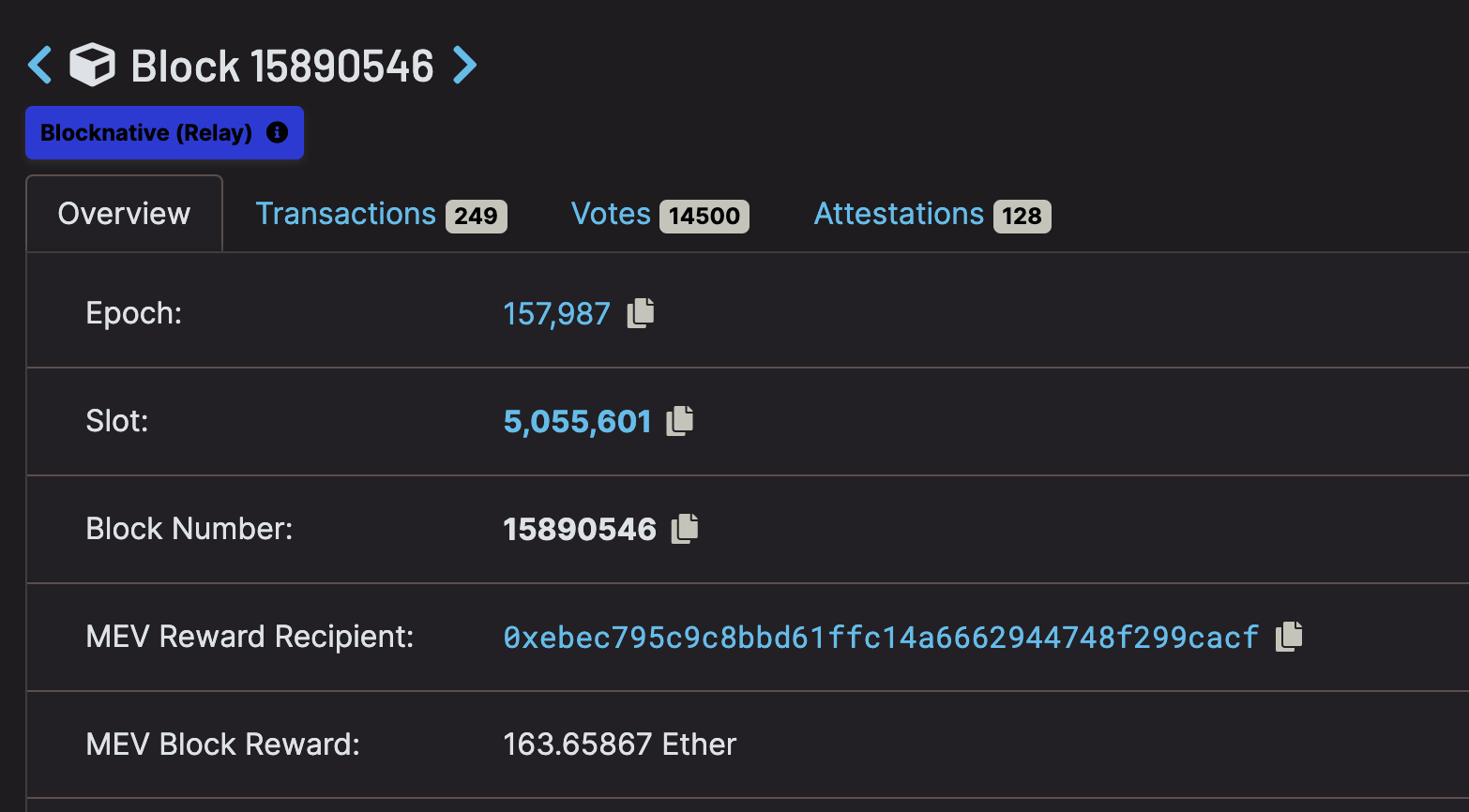Block rewards are the ultimate prize for any Ethereum staker. Whether or not a validator secures them can make or break the ROI on an ETH staking operation as block rewards tend to make up over 90% of the ~5% APR for stakers.
A common misconception is that this APR is a given for anyone that stakes ETH. In reality, there are several choices stakers should consider when trying to maximize their ability to both secure block rewards and make the most of the block rewards they capture.
In this article, we will cover what an Ethereum block reward is and the strategies that validators/stakers can use to ensure that they are making the most of their opportunities in the block reward lottery.
What are Ethereum Block Rewards?
On Ethereum’s Beacon Chain, the network produces blocks of transactions once every 12 seconds in periods known as “slots”. For every slot, there is an individual validator randomly chosen to “propose” the corresponding block.
Ethereum block rewards (or “proposer rewards”) are a built-in mechanism to incentivize proper behavior on the part of the validators that propose blocks. When a validator completes this task by proposing a valid block that is subsequently attested by all other validators, they receive a block reward.
Two guaranteed sources of funding and one optional source of funding make up the value of a block reward:
- Guaranteed - Consensus rewards: The Ethereum developer docs outline this payment as follows - A validator that has made timely source, target and head votes, proposed a block and participated in a sync committee could receive 64/64 * base_reward == base_reward. Essentially, these are rewards paid by the Ethereum protocol itself to validators securing the network.
- Guaranteed - Execution rewards: Users of the Ethereum network pay priority gas fees to complete transactions. Block proposers then receive the sum of all priority fees within the block that they propose. For a full analysis of what priority fees are and how they work, we recommend our guide to EIP-1559.
- Optional - MEV-Boost rewards: MEV searchers make payments to validators based on the profits they receive from their transaction bundles. These bundles are packaged together with other transactions by block builders and then delivered to validators via the optional protocol sidecar MEV-Boost. A validator must opt into utilizing MEV-Boost to capture these rewards.
Based on median total historic reward data, block rewards that do not contain MEV-Boost rewards total roughly .024 ETH. On the other hand, block rewards with MEV-Boost rewards total roughly .064 ETH. Since a single validator should propose about 5 blocks per year, this increase in margin can significantly improve the ROI for an individual validator.
Information on Ethereum block reward payments is publicly viewable via Beaconcha.in. Locally produced blocks—meaning blocks not outsourced to MEV-Boost—will have a field for “Fee Recipient” identifying the address that received the block reward along with a “Tx Reward” field listing the amount paid:
Blocks sourced via MEV-Boost, on the other hand, will typically be identified by the relay they come from and list a “MEV Reward Recipient” and “MEV Block Reward” field. These MEV block rewards are the sum of all rewards paid out to the proposer (validator), including priority gas fees, MEV, and potential block subsidies.
How Can Node Operators Maximize Their Block Reward Opportunities?
Connecting to Multiple Relays
The most crucial thing that validators can do to maximize their block reward opportunities is to utilize MEV-Boost. Once the sidecar is in place, MEV-Boost relays enable validators to earn more profit by connecting their nodes to specialized block builders that compete to produce the most profitable block possible for each slot.
By connecting to a diverse set of relays, a validator can increase the pool of block builders from which they receive blocks. Different relays are connected to different block builders, and different block builders are subsequently connected to a variety of MEV searchers — sophisticated actors that specialize in profit extraction.
As a result, some block builders may produce more valuable blocks than others depending on the unique MEV they contained, the block builder's infrastructure capabilities, or their view of the mempool. Because MEV-Boost will always choose the block with the highest bid, it is most lucrative for validators to connect to as many trusted relays as possible to increase the diversity of blocks they receive. Connecting to multiple trusted relays also ensures that a validator will have additional options to fall back on for block production if one relay fails.
Run Multiple Validator Nodes if Possible
While MEV-Boost is the single most important ROI factor for each individual validator, the easiest way to boost the performance of an Ethereum staking node is to run multiple validators.Here’s why: Two pieces of software, a consensus client and an execution client, make up an Ethereum node. If you have the hardware and knowledge to operate these pieces of software + 32 ETH, you can run a validator.
But what if you have more than 32 ETH? For every additional 32 ETH, a single node can run another validator. This means you can continue spinning up multiple validators and increasing your odds of being selected as a block proposer with no additional resources spent on hardware or software.
Operating an Ethereum validator node is far easier than Proof-of-Work (PoW) mining, but the resources and commitment needed to do it properly are not to be taken lightly. You still must pay for high-quality hardware and electricity. These costs can eat into ROI if you are only operating a single validator, but with multiple running off the same base cost your potential for making profits increases dramatically.
Avoid Penalties and Slashing
Validators must not forget the basics. A validator has no opportunity to capture block rewards if it is improperly configured or being slashed. We highly recommend that anyone who is looking to learn more about PoS Ethereum review our guide to slashing and other staking penalties so that they fully understand the potential risks that go along with staking rewards.
How Can Stakers Maximize Their Block Rewards?
Consider Joining a Staking Pool
For users that do not have the 32 ETH required to run a validator node (or who do not feel comfortable with the technical hurdles), pooled liquid staking via services such as Lido, Rocket Pool, or Stakewise offer an easy way to earn a return on holding ETH.
These services allow individual users to pool their ETH together and operate large amounts of validators. They also offer more dependable staking rewards because they smooth out the variability of running an individual validator. You always have the chance to hit a lottery block with your own validator, but you can also be unlucky and fail to win lucrative blocks. If you’re extremely unlucky, you could even fail to win blocks at the normal frequency rate.
Because staking pool operators operate such a large number of validators (Lido alone operates over 150,000) they can more regularly capture the high-value blocks that tend to boost staking ROI. These returns are then evenly spread amongst the various stakers so that even someone staking a fraction of ETH can receive a dependable 4-5% APR.
Encourage Relay Diversity With Pool Operators
Relay diversity and optimization is just as important for large pool and staking-as-a-service operators as it is for solo stakers. This has been acknowledged by operators such as Lido and Coinbase, but as the proto-PBS landscape continues to evolve it’s important that individuals staking with these services continue to monitor their commitment and follow through towards maintaining validators that offer the best ROI opportunity.
It is also important to recognize that these operators are in charge of huge swaths of validators on the network. If there are technical issues with their systems, it could have serious repercussions for Ethereum as a whole. When these operators connect to many different MEV relays with diverse codebases, it ensures that no single team or piece of infrastructure becomes overwhelmingly central to the network’s operation.
Pushing pool operators to embrace relay diversity protects the ROI interests of ETH stakers while also protecting against the tail risk of large-scale software problems with Ethereum as a whole. If you are a pooled staker, we highly recommend looking into what the MEV-Boost policy of your staking provider is and whether or not they have connected to a diverse set of relays.
Winning the Mempool Lottery
The dynamic ebbs and flows of economic activity on Ethereum offer a particularly interesting “lottery” aspect for validators that are selected as block proposers. Sometimes, due to a huge demand for transaction space in a limited window of time, priority fees for Ethereum will skyrocket.
When this happens block rewards can balloon to levels far exceeding the average. NFT drops are a common trigger for this type of network usage because they generally occur over a small window of time. When Bored Ape Yacht Club creators Yuga Labs executed their famous Otherside launch, gas fees skyrocketed as users competed to be one of a select few to mint an Otherdeed before they were all gone.
Since the Otherside launch occurred before Ethereum’s Merge and switch to PoS, the value of captured priority fees was accrued to Ethereum PoW miners. Now that Ethereum operates under a PoS system, these priority fee bidding wars accrue to a single lucky validator.
A recent example of this comes from the KPR NFT mint. The block below was produced during the timeframe of the mint and netted one lucky validator an astounding 163 ETH value:
Thanks to our years of experience operating low-latency, highly reliable infrastructure for Ethereum, Blocknative’s builder + relay optimizes validators for profitability under the conditions that lead to these massive blocks. The metrics below showcase block rewards from recent NFT drops that were produced via Blocknative’s builder:

Validators can ensure that they are prepared to win the block reward lottery by connecting MEV-Boost to the Blocknative Relay endpoint. If your validator is already connected to MEV-Boost you can deploy the Blocknative Relay in one step.
One Step Deployment
#In your systemd file add in the following specification:
./mev-boost -mainnet -relay-check -relays https://0x9000009807ed12c1f08bf4e81c6da3ba8e3fc3d953898ce0102433094e5f22f21102ec057841fcb81978ed1ea0fa8246@
builder-relay-mainnet.blocknative.com
Use Environment Variables for Multi-Relay Manageability
#Copy and paste the following:
[Unit] Description=mev-boost
[Service]Type=simple Restart=on-failure RestartSec=5s User=validator Environment=BN_RELAY="https://0x9000009807ed12c1f08bf4e81c6da3ba8e3fc3d953898ce0102433094e5f22f21102ec057841fcb81978ed1ea0fa8246@builder-relaymainnet.blocknative.com" Environment=FB_RELAY="https://0xac6e77dfe25ecd6110b8e780608cce0dab71fdd5ebea22a16c0205200f2f8e2e3ad3b71d3499c54ad14d6c21b41a37ae@boost-relay.flashbots.net" ExecStart=/usr/local/bin/mev-boost \ -mainnet \ -relays $BN_RELAY,$FB_RELAY
Build With Blocknative
Blocknative strives to strengthen Ethereum’s network by providing world-class pre-chain infrastructure. In addition to our block building and relay services, we offer a suite of tools to allow MEV searchers to gain an edge in finding opportunities. Bundles can then be delivered securely on-chain via our builder’s bundle RPC endpoint.
If you have any questions we encourage you to join our Discord community for direct access to the Blocknative team. You can also follow us on Twitter @Blocknative for the latest updates.
Gas Extension
Blocknative's proven & powerful Gas API is available in a browser extension to help you quickly and accurately price transactions on 20+ chains.
Download the Extension





